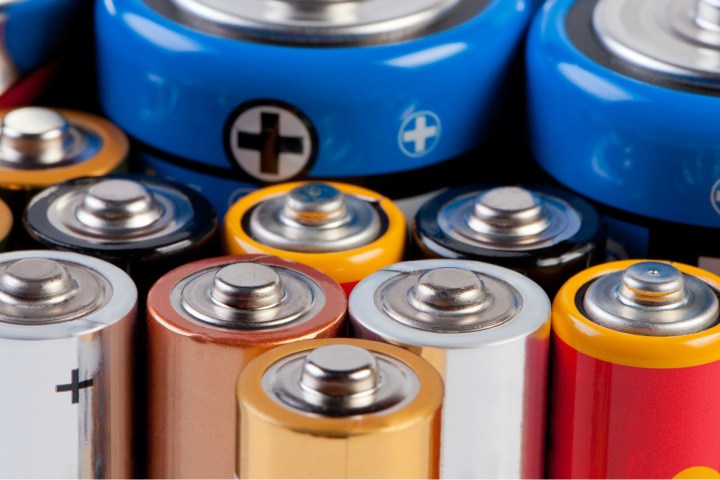
Although the great producers of electricity, colossi like the Hoover Dam, may be the most viscerally impressive, human mastery of electrical currents is perhaps most impressive in the form of batteries. Some small enough to sit on the tip of a finger, batteries power many of the devices we use every day: phones, laptops, flashlights, watches. They have been an omnipresent part of life for decades now, but how many of us know how they work?
Beneath their simple exteriors, a simple mechanism
A typical alkaline battery will be familiar to many people, at least from the outside. Generally encased in a metal cylinder, the battery has two ends marked as + (positive) and – (negative). The two ends of a battery are terminals, connected to electrodes within the battery: the positive end connects to a cathode, while the negative end connects to an anode. A separator inside the battery keeps the two from touching, while allowing electricity to flow between them. Between the two ends is an electrolyte paste, a substance that allows for the flow of electrical current.

Electrons naturally want to flow from the negative end (where there are excess electrons) to the positive end (where there are open spaces for electrons), however they cannot do so because the separator blocks their path. By connecting the positive and negative ends of the party, a circuit is formed that allows electrical current to flow.

When a battery is plugged into a device, such as a flashlight or remote, a circuit is established and chemical reactions occur in the anode and cathode. In the anode, an oxidation reaction occurs, where ions combine with the anode and release electrons. In the cathode, a reduction reaction occurs, with ions and electrons forming compounds. In these oxidation-reduction reactions, electrons are flowing from the negatively charged anode to the positively charged cathode.
In an alkaline battery, the anode is made of zinc, while the cathode is manganese dioxide. The electrodes in these batteries erode over time. Rechargeable batteries are usually made of lithium-ion. When plugged in to recharge, the flow of electricity reverses, returning the anode and cathode to their original states.
A brief history of batteries
The earliest object resembling a battery may have been built as early as the 3rd century AD, in the form of clay pots uncovered in 1938 by a German painter, Wilhelm König, near Baghdad. Inside each pot was an iron rod wrapped in a sheet of copper. There was enough room in the jars to contain some sort of electrolyte solution, and so König believed the pots to be galvanic cells, possibly used by inhabitants of the Sasanian Empire for electroplating, the process of using an electric current to produce a metal coating.
Sure enough, experiments aimed at recreating these devices (including one by the popular show MythBusters) have found that the design can produce a small voltage, large enough for electroplating. Despite this, most archaeologists today believe that the pots were not used as batteries in the period they were built, but rather as storage vessels for sacred scrolls. Metallic coatings in the period the jars were built was done through a process of fire-gilding, so König’s electroplating theory seems flimsy. Whatever purpose the Baghdad batteries were designed for, they are at least an interesting curio, inadvertent proto-batteries built long before scientists would come to better understand electrical currents.
The first true battery was built in 1800 by Alessandro Volta. In his days as a professor at the University of Pavia, Volta worked with Luigi Galvani, a biologist who discovered while dissecting a frog that, when his scalpel touched the brass hook holding the frog up, its legs would twitch. Galvani (who would inspire the word “galvanize”) believed that this was evidence of an electrical force that animates life, which he dubbed “animal electricity.” Volta reproduced Galvani’s experiment, but came to a different conclusion: it was the connection between the metal scalpel and hook, not the life force of the frog, that produced an electrical current.
Volta’s research led him to create the voltaic pile, stacking discs of zinc and silver, with cardboard soaked in saltwater between them. Connecting the top and bottom disc with a wire, Volta was able to produce an electrical current, and lay the foundation for future batteries. In honor of Volta’s work, the unit of measurement for electrical potential is known as the volt.
The battery as we know it today is a relatively recent invention. Working for Union Carbide on the Eveready battery line in the 1950s, engineer Lewis Urry was given what seems today like a remarkably mundane task: make longer lasting batteries for toys. Rather than improve on the existing design as his bosses expected, Urry decided to create a new battery, and eventually settles on using a mixture of manganese dioxide and powdered zinc. Thus, Urry created the modern alkaline battery, capable of powering devices for exponentially longer than the previous commercial batteries. Although the first alkaline batteries hit the market in 1959, frequent improvements have kept them viable even to the present day.


